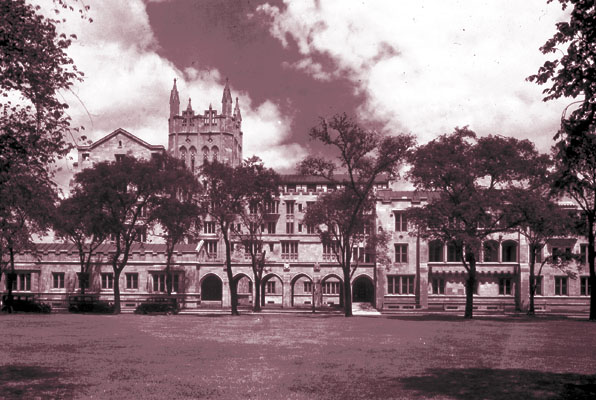
The history of Chicago Lying-in begins in 1895 in the mind of a young, recently graduated medical student named Joseph Bolivar DeLee. The story of Dr. DeLee and the hospital he founded is, in impresive measure, the story of the development of modern obstetrics. At the end of the 19th century, obstetrics was a neglected and almost despised branch of medicine. Medical students were graduating without practical training in obstetrics, and many physicians refused maternity cases. Hospitals were used only by those too poor to pay for housecalls by doctors, and the hospitals were often filthy. Despite then recent discoveries about the prevention and treatment of disease, Dr. DeLee observed doctors delivering babies daily throughout his internship without so much as washing their hands, much less using a disinfectant. These unsanitary conditions resulted in puerperal or childbed fever, which killed more than 20,000 mothers each year.
Dr. DeLee theroized that cleanliness had a direct effect on a mother's chance of survival in the hospital. Furthermore, he dreamed of developing a free clinic for the poor and establishing a maternity hospital that would offer better obstetrical care for mothers and better training for doctors. In January 1895, with $200 from the Young Men's Hebrew Charity Association and $300 from several individuals, he rented four small rooms at Maxwell Street and Newberry Avenue. At noon on February 14, 1895, he opended the Chicago Lying-in Dispensary, Chicago's first outpatient clinic to provide maternity care for needy women and to train medical students.
At first, Dr. DeLee waited for patients--but none came. Women were untrusting of a young doctor offering free services. At times Dr. DeLee paid his patients 25 cents to let him deliver their babies.Eventually word of successful deliveries spread and women sought out Dr. DeLee's high standards of cleanliness. Senior medical students, student nurses and interns came from all over the continent to work and learn with Dr. DeLee. At the end of the first year, the Dispensary had 204 deliveries. The following year, in April 1896, larger and cleaner quarters were obtained across the street and a training school for obstetrical nurses was established. By the end of 1896, 52 students and 12 physicians had been instructed in practical obstetrics.
As his work load grew, Dr. DeLee recognized the urgent need for a maternity hospital. While most of the financial support of The Dispensary had come from Dr. DeLee's own private funds, he now sought the help of a Women's Board to raise money. A small 15-bed hospital in a remodeled house on Asland Boulevard opened in 1899. In 1904 ,The Mother's Aid, a group of women founded by Dr. DeLee's sister Mrs. Ida Neuman, accepted the challeged to raise money for a hospital specifically for isolation of infectious cases. In 1908, The women's board began aggresively to raise money for a larger Lying-in Hospital. The culmination of the early work of these two groups resulted in the opening of the Mother's Aid Pavillion in November 1914 and the main maternity hospital in 1917.
With the opening of the first Chicago Lying-in Hospital in 1917, the world-wide renown of Dr. Delee and CLi was firmly established. Chicago Lying-in became the model for maternity hospitals throughout the world. Doctors and nurses came from around the world came to study there. Epidemics of child-bed fever were virtually eliminated.
For many years an affiliation between Rush Medical College and The University of Chicago existed when students spent their first two years at the University and their last two years at Rush. Following the famous Flexner report, a critique of medical education in the United States, it was decided to develop a four-year program at The University of Chicago.
In 1927, the Board of Directors decided that CLi Hospital's teachings could be more effectively conducted through an affiliation with the Medical School of the University of Chicago. The Board of Directors and the Mothers' Aid began another vigorous campaign to raise money, and in three years had the funding to build a new Chicago Lying-in Hospita,l and a new Mothers' Aid pavillion for isolation cases, on the University's hospital site. The new building was officially opened in May 1931 and on May 25, 1931 the first baby was delivered in the new hospital by Dr. DeLee. In 1938, at the request of the Board, the Chicago Lying-in Hospital was merged with the University Clinics. The Board has since devoted itself to supporting, financially and through volunteer service, the general program of CLi. The Mothers' Aid continued to raise money through two highly successful ventures: the Gift Shop in the lobby and the publication of Our Baby's First Seven Years, both of which are still in existence today.
The hospital, which functions as a unit dedicated to the health care of women, has 63 beds. In addition, there are complete outpatient facilities for the care and study of mothers during pregnancy, and of women with gynecological complications.
askfj asjdf a;sldfj a;slkjf ;alskjf ;alsdf laskjf ;lsadjf ;ldsjaf lsadjf ;lsadjf l;askjfd ;lasdf ;laskdf ;lasjdf ;laskjf ;las dfl;a lkds aljfka klfja dflkj adsflkja flksad flks daflsda fl;sjad l;sdj ;laskj a;lskjf al;kjwe lkjwroiuer k.sdf wioeruw; oafksa dn;laiwue sdjfn a;ieut sfgl as;o8ueb iusad;f as;oifue jsx fjaeso9 ajsf
Copyright ©1998-9 Dept. of Obstetrics and
Gynecology, University of Chicago. All rights reserved.
Send questions and comments about this page to ljewell@babies.bsd.uchicago.edu.
Please note: We do not answer on-line medical inquiries.